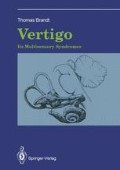Abstract
This vertigo is associated with exposure to alterations in ambient pressure, either an increase (diving) or a decrease (flying). The atmosphere exerts an absolute pressure of 760 mm Hg at sea level, the standard one atmosphere absolute (1 ATA) pressure. Changes of pressure in water increase linearly with increasing depth: one atmosphere is added for each 33 ft. This increased pressure is balanced by breathing air delivered at the new ambient pressure and by equalising the pressure in all gas-containing body cavities to ambient (Farmer and Thomas 1976; Margulies 1987). The volume of gas varies inversely with ambient pressure and this pressure–volume relationship mostly causes the barotrauma. The likelihood of damage to the Eustachian tube and middle and inner ear increases as the rate of change of external pressure increases, because it is in these areas that large pressure differentials are produced.
Access this chapter
Tax calculation will be finalised at checkout
Purchases are for personal use only
Preview
Unable to display preview. Download preview PDF.
References
Armstrong HG, Heim IW (1937) The effect of flight on the middle ear. JAMA 109:417–421
Brandt Th, Dieterich M, Fries W (1988) Otolithic Tullio phenomenon typically presents as paroxysmal ocular tilt reaction. Adv Oto-Rhino-Laryngol 42:153–156
Edmonds C, Freeman PB (1972) Inner ear barotrauma. Arch Otolaryngol 95:556–563
Farmer IC, Thomas WG (1976) Ear and sinus problems in diving. In: Strauss (ed.) Diving medicine. Grune and Stratton, New York, pp 109–133
Goodhill V (1971) Sudden deafness and round window rupture Laryngoscope 81:1462–1474
Head PW (1984) Vertigo and barotrauma. In: Dix MR, Hood JD (eds) Vertigo. John Wiley and Sons, Chichester New York, pp 199–215
Lundgren CEG, Malm LU (1966) Alternobaric vertigo among pilots. Aerospace Med 37:178–180
Margulies ADC (1987) A short course in diving medicine. Ann Emerg Med 16: 689–701
Nakashima T, Itoh M, Sato M, Watanabe Y, Yanagita N (1988) Auditory and vestibular disorders due to barotrauma. Ann Otol Rhinol Laryngol 97:146–152
Wicks RE (1989) Alternobaric vertigo: an aeromedical review. Aviat Space Environ Med 60:67–72
Author information
Authors and Affiliations
Rights and permissions
Copyright information
© 1991 Springer-Verlag London Limited
About this chapter
Cite this chapter
Brandt, T. (1991). Vertigo Due To Barotrauma. In: Vertigo: Its Multisensory Syndromes. Clinical Medicine and the Nervous System. Springer, London. https://doi.org/10.1007/978-1-4471-3342-1_18
Download citation
DOI: https://doi.org/10.1007/978-1-4471-3342-1_18
Publisher Name: Springer, London
Print ISBN: 978-1-4471-3344-5
Online ISBN: 978-1-4471-3342-1
eBook Packages: Springer Book Archive

